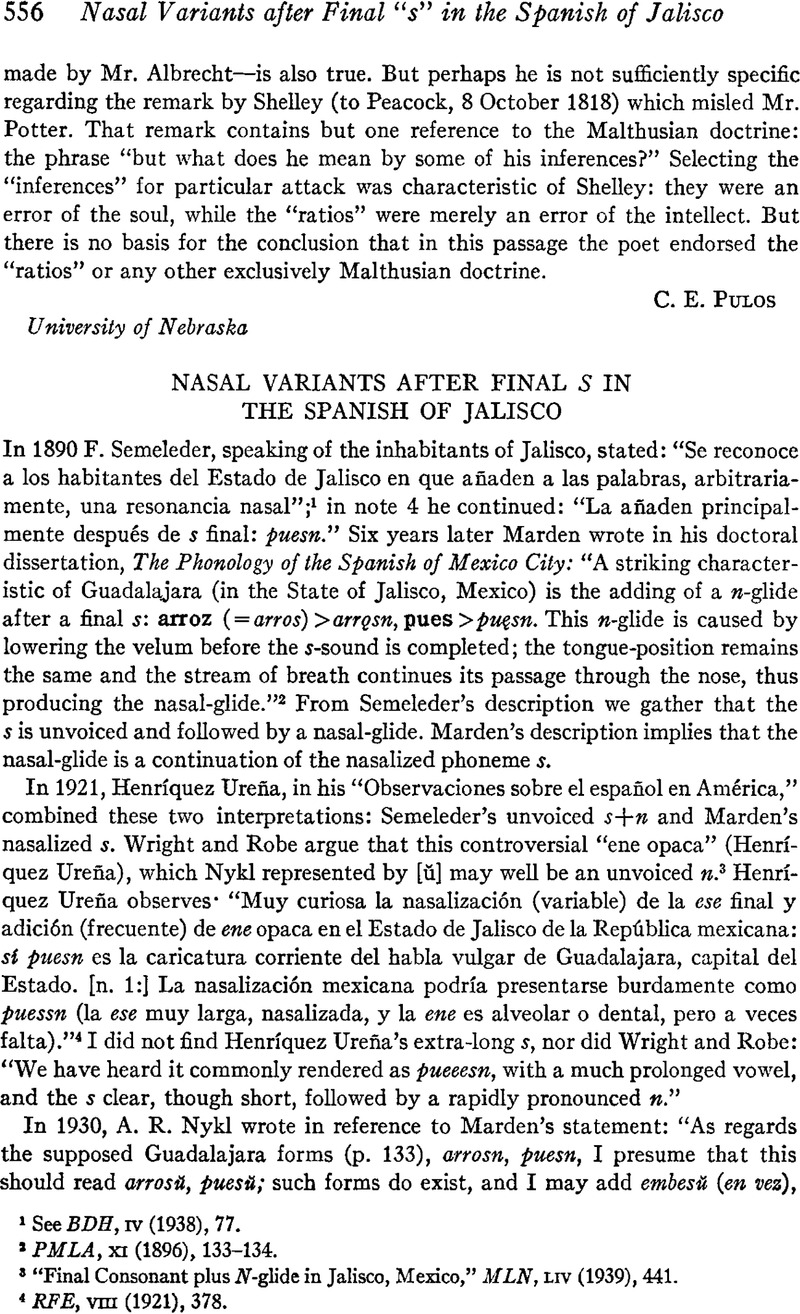Article contents
Nasal Variants after Final S in the Spanish of Jalisco
Published online by Cambridge University Press: 02 December 2020
Abstract

- Type
- Article Commentary
- Information
- Copyright
- Copyright © Modern Language Association of America, 1955
References
1 See BDH, iv (1938), 77.
2 PMLA, xi (1896), 133–134.
3 “Final Consonant plus N-glide in Jalisco, Mexico,” MLN, liv (1939), 441.
4 RFE, viii (1921), 378.
5 “Notes on the Spanish of Yucatan, Vera Cruz, and Tlaxcala,” MP, xxvii (1930), 458, n. 5.
6 “Final S plus N-glide in Mexico,” MLN, xlix (1934), 18–19.
7 “A Dialect and Folkloristic Study of Texts Recorded in Los Altos of Jalisco, Mexico,” Univ. of North Carolina Thesis (1949), ?174. Wright believes he has heard it as far north as Chihuahua in the speech of a servant (p. 19).
8 Navarro Tomás, Cuestionario lingiiislico hispanoamericano, 2nd ed. (Buenos Aires, 1945), p. 40, ?17.
9 The 2 points where I observed the final j plus e plus an alveolar n are adjacent to the 3 points (Acatic, Mezcala, and Jalostotitlán) where Robe observed the same phenomenon through recorded texts. By sheer coincidence none of the localities for which Robe presented recorded texts was studied by me.
10 Some may hold that this vocalic quality is closely related to the etymological e after d and r as described by Menéhdez Pidal in the Canlar de mio Cid as well as the antietymo-logical or paragogic e after s (mase, sone) described in the same work (Madrid, 1946, pp. 1177–84), a viewpoint that had first appeared in RFE, xx (1933), 345–350. This is hardly possible since in order to call this an etymological e it would be necessary to confirm the existence of the e from the 12th century to the present phenomenon of Jalisco. There is no diachronic evidence that spoken Spanish uses this e anywhere.
11 Henriquez Urefia, “Datos sobre el habla popular de Mexico,” BDH, iv (1938), 320. Luis Flórez, La pronunciation del español en Bogota (1950), ?143. Berta Elena Vidal de Battini, “El habla rural de San Luis,” BDH, vii (1949), 30, 40, 78, 101. Rodolfo Lenz, “El espanol en Chile,” BDH, vi (1940), 153, 188. Aurelio M. Espinosa, “Estudios sobre el espafiol de Nuevo Méjico,” MDH, i (1903;, 192,264 n.
12 Letter from Dr. Robe, 12 Feb. 1952.
13 Flórez, pp. 252, 255.
14 Carroll L. Riley, “Trade Spanish of the Paftaguero Panare,” SIL, xi (March 1952), 9.
15 Manual de entonación española (Hispanic Inst., 1944), p. 142.
16 Otto Jespersen. The Philosophy of Grammar (New York 1924), p. 303.
17 Navarro Tomás, Manual de entonación espanola, p. 78.
18 This is a revision of a paper read at the 1951 meeting of the MLA.
- 1
- Cited by




